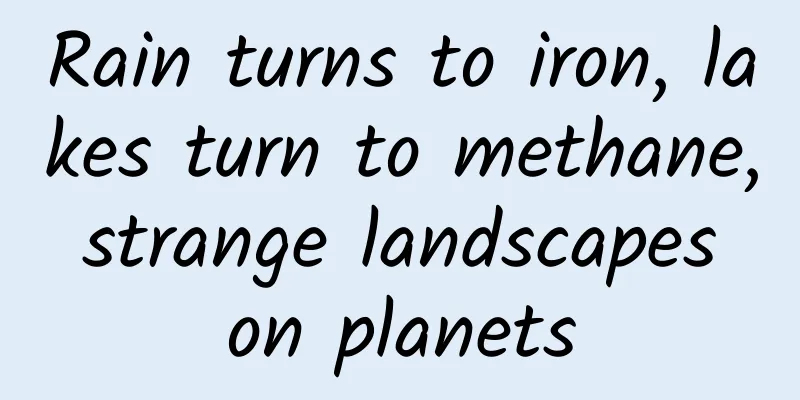Rain turns to iron, lakes turn to methane, strange landscapes on planets

|
What will it be like when dust storms appear on Mars, when lightning strikes on Jupiter, and when weather phenomena occur on other planets? Illustration: An artist's image of the alien planet WASP-76b. Image credit: Frederik Peeters This article originally appeared in The Conversation. The Conversation contributed this article to Space.com's Expert Voices: Op-Ed & Insights. When Oscar Wilde coined the phrase "Conversation about weather is the last refuge of man without imagination," he was unaware of some of the more extreme weather on planets and moons beyond Earth. Since the first exoplanet was discovered in 1992, more than 4,000 planets have been discovered orbiting stars other than our own. The study of exoplanets includes: Trying to determine the composition of the atmosphere of an exoplanet, primarily to determine whether life could exist there. In the search for life, astronomers have discovered a large number of potentially host worlds. Here are four examples of weird weather on other celestial bodies to demonstrate just how variable an exoplanet's atmosphere can be. Iron rain on WASP-76b Astronomers have discovered WASP-76, a large, hot exoplanet. The surface of WASP-76 is about twice as hot as Jupiter, with temperatures as high as 4,000 degrees Fahrenheit (2,200 degrees Celsius). This means that many materials that are solid on Earth, such as iron, would melt and vaporize on WASP-76b. "On the day side of the planet, facing its star, this iron is turned into gas," one particularly famous study described. "It rises in the atmosphere and flows toward the night side." When this gaseous iron reaches the night side of the planet, where temperatures are lower, it condenses into liquid and then falls to the surface. This is the only example so far where WASP-76's temperature changes enough for it to actually rain iron at night. Illustration: Artist's illustration of the night side of WASP-76b. This ultrahot giant exoplanet has a day side with temperatures reaching over 4,350 degrees Fahrenheit (2,400 degrees Celsius), hot enough to vaporize metals. Strong winds carry iron vapor to the cooler night side, where it condenses into iron droplets. On the left side of the image is the exoplanet's evening side, where the transition from day to night occurs. Image credit: ESO/M. Kornmesser Methane lakes on Titan Titan is not really a planet, but rather the largest moon of Saturn. It is very interesting because it has a fairly large atmosphere, which is unusual for a moon orbiting a planet. On Titan's surface, there are rivers of liquid flowing, just like on Earth. But unlike on Earth, this liquid is not water, but a mixture of different hydrocarbons. On Earth, we would use these chemicals (ethane and methane) as fuel, but on Titan, it's cold enough that they remain liquid and form lakes. Cryovolcanoes are thought to sporadically eject these hydrocarbons into the atmosphere as gases, which form clouds that then condense as rain. But this precipitation is different from the showers we get on Earth because it only falls about 0.1% of the time, and the raindrops are larger (about 1 cm) and fall five times slower due to reduced gravity and increased drag. Illustration: Methane lakes on Titan. Image source: NASA/JPL-Caltech Wind on Mars Mars has a completely different weather system than Earth, mainly because Mars is very dry and has a much thinner atmosphere. With no significant magnetic field, the Martian atmosphere is open to the Sun's magnetic field, which strips away the upper atmosphere. This leaves behind a thin atmosphere composed mainly of carbon dioxide. The first powered flight of NASA's Ingenuity helicopter on Mars was surprising - not only because of the exploration factor, but also because the rotors provide very little lift in the thin atmosphere, about 2% of that on Earth's surface. Against this thin atmosphere are dual sets of large blades that spin at about 2,500 revolutions per minute, roughly the speed of a drone rotor but much faster than a passenger helicopter. Although Mars' atmosphere is thin, it is far from calm: average winds of 30 km/h (20 mph) are strong enough to move surface material around, and early observations by the Viking landers measured winds as high as 110 km/h (70 mph). Mars is famous for having massive dust storms that obscure the view of the surface and can last for weeks. So the prospect of high-speed dust storms is a major problem for exploring the planet, but because the atmosphere is so thin, there is very little pressure in the atmosphere. For example, the scene in the movie "The Martian" where the rocket gets blown over would never happen. Illustration: Mars before (left) and during (right) a dust storm. Image credit: NASA/JPL-Caltech/MSSS, CC BY Lightning on Jupiter In 1979, Voyager 1 flew by Jupiter and witnessed lightning strikes on the planet. In 2016, the Juno mission took an in-depth look at lightning storms on Jupiter. On Earth, most lightning is concentrated near the equator. But on Jupiter, the stability of the atmosphere means that most convection and turbulence occurs near the poles, which is also the main location for lightning. On Jupiter, lightning is not generated the way it is on Earth, but by supercooled water droplets colliding with ice, accumulating electrical charges in snowballs of ammonia. This ammonia acts as an antifreeze for the water, keeping it liquid at higher altitudes. Jupiter even has lesser-known lightning, called spooks and elves. Spooks are formed by lightning that rises from clouds into the upper atmosphere and creates a brief red glow, while spooks are rings that form when lightning strikes the electrically charged part of our atmosphere (the ionosphere). These were predicted in 1921 but weren't photographed from Earth until 1989, mostly due to obstruction from storm clouds. Image credit: NASA/JPL-Caltech/SwRI BY: Ian Whittaker FY: Qiu Bai If there is any infringement of related content, please contact the author to delete it after the work is published. Please obtain authorization for reprinting, and pay attention to maintaining integrity and indicating the source |
<<: Why do some people get diarrhea after drinking milk? It turns out that this is the "trouble"
Recommend
[National Cancer Prevention and Treatment Week] How to prevent and treat these 5 common infections after colorectal cancer surgery? This article will teach you!
It is reported that despite strict aseptic measur...
NIO is sinking, sub-brands Alpine and Firefly are about to be launched, focusing on increasing sales
Recently there have been reports that NIO's s...
For an Internet finance platform, is a 30% increase in the number of users each month considered "growth"?
What is growth? Any growth that is not aimed at i...
How much does it cost to produce a real estate mini program on the market in Baishan?
Baishan real estate applet production price 1. Di...
Apple search association words have become the hot spot of ASO again. What is the display logic?
The day before yesterday, there was an article ab...
National Disability Day丨Today, forward for love!
May 15th is the 32nd National Day for Persons wit...
Animal children also have to do homework, and there are even parents who are too picky about their children
When you don’t want to go to school or work, have...
The dream of a minimalist smartphone is beautiful, but the reality is bleak
On July 1, Wired published an article saying that...
Are projectors really better for your eyes than TVs? Before buying a projector, just know these 3 things!
There are so many projectors on the market now, n...
These 7 habits you thought were "healthy" might be wrong!
my country's population has gradually shown a...
Is the prediction of "The Three-Body Problem" coming true? The Milky Way may be losing dark matter
We all know that the ending of "The Three-Bo...
Souwai.com Tutorial: Teacher Fu Wei’s Website SEO Optimization Training Video Tutorial (24 Lessons)
As a popular SEO training academy in the SEO trai...
How much does it cost to develop the Wuhan Aquatic Products Mini Program? How much is the price for developing Wuhan Aquatic Products Mini Program?
According to industry insiders, mini programs wil...
11 real dilemmas and thoughts on To B operations
To B is a good business, but it is also true that...
Not only does white porridge not nourish the stomach, but drinking it for a long time can actually damage the stomach!
Recently, Dr. Zhang Wenhong, who is on par with Z...









